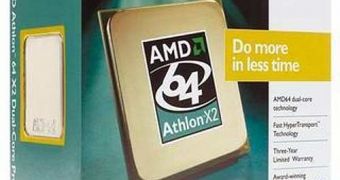Just as everybody knows, AMD went through a particular difficult period that is not over yet. The computer processor manufacturer is hoping for a breakthrough thanks to its yet to be released quad core Barcelona server and desktop processors. AMD, just like many other computer hardware producers, is trying to expand its product offerings in an attempt to gain both more market shares and to have more stable revenues even if a market segment becomes really unstable and produces none or poor income.
To make this happen, AMD decided to merge with the graphics chips producer ATI, a sound solution given the fact that the graphics cards market is much more stable than the processor market. "Asset Light", as the new market and products strategy is called, is the term AMD uses for "the ongoing incorporation of AMD and ATI interests and resources, the optimization of those resources, and the utilization of existing assets to their fullest extent" according to the Web based news site Ars Technica.
At the AMD's Analyst Day presentation, the company spokespersons took time to explain the joint ventures AMD is interested in, ventures that include the participation on big names like IBM, Chartered and TSMC. One major point the company made during said presentation was that it is currently running at top efficiency and it has plans to upgrade some of its production line in the near future in order to use the 55 and the 45-nanometer production technologies. As the equipment to upgrade its own processor making facilities costs very much, AMD decided to charter a part of its production needs to companies like TSMC and Chartered and take its time to upgrade its own facilities because of the huge financial losses suffered this year. "Doug Grose, senior vice president at AMD in charge of manufacturing, reiterated that "asset light" does not mean dumping all of AMD's chip plants and embracing the fabless model", according to the news site News.com. The vice president, however, talked about plans to introduce processors made with the 45 nanometer technology on the market in 2008.
About the price war between Intel and AMD, the executive vice president and the company's chief sales and marketing officer, Henri Richard, said it was an "unfair fight" as his company had no way of really winning because it was a battle against Intel's quad core chips using only older and slower dual core ones. As the company still has yet to launch its quad core processors, it must use for now the lower end computer market and thankfully that market is growing fast. With new big names on the customers list like Dell and Toshiba (the Japanese firm finally decided to make a line of laptops using AMD processors), the company can breathe a little easier. Henri Richard said that AMD's position is still somehow stranded: "We have customers, they are asking me to supply them with the products they need, and I can't just say no".
Even with adding big customers to the list, AMD has a lot of money and market shares to regain, as neither Dell nor Toshiba were willing to pay the full market value for the processors supplied, but the chip maker had to agree to a lower price in order to keep its position on the market. "We're not chasing share for share's sake," Richard said. "The company believes it can erase its losses and improve its average selling prices with the launch of its quad core Barcelona chip in August, and new chips for desktops and notebooks over the next several months."

 14 DAY TRIAL //
14 DAY TRIAL //